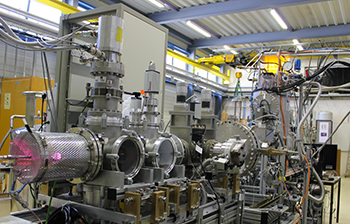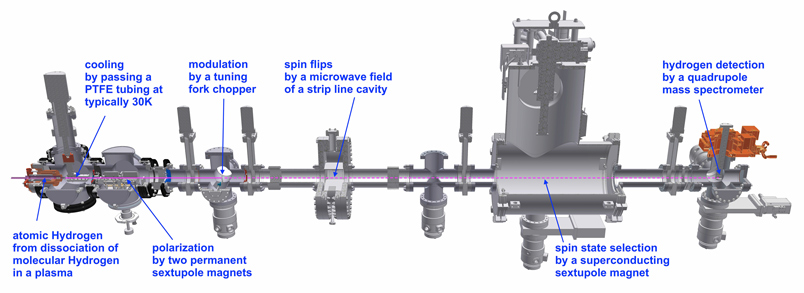Atomic hydrogen beam
The ASACUSA collaboration has built a beam of cold atomic
hydrogen with the initial aim to test the components of the
antihydrogen hyperfine spectroscopy line. The setup can be
also used to set limits to some coefficients of the
non-minimal Standard Model Extension (ref. 1).
Purpose
 The
reliable operation of the antihydrogen hyperfine spectroscopy
apparatus is a basic prerequisite for the proposed CPT test
and it requires a careful characterization of every component
of the experiment, which can be done with hydrogen (with the
obvious exception of the annihilation detector). The
spin–flip cavity and the superconducting sextupole magnet can
be tested just as well with conventional atomic hydrogen.
Therefore, a source of cold and polarized atomic hydrogen had
been constructed and tested at SMI. It was shipped to CERN in
late 2013 and has successfully been operated since 2014. This
project resulted in a detailed characterization of the
spin–flip cavity and the superconducting sextupole magnet, as
well as a high precision verification (to a few parts per
billion) of the apparatus and the measurement principle (ref.
2).
The
reliable operation of the antihydrogen hyperfine spectroscopy
apparatus is a basic prerequisite for the proposed CPT test
and it requires a careful characterization of every component
of the experiment, which can be done with hydrogen (with the
obvious exception of the annihilation detector). The
spin–flip cavity and the superconducting sextupole magnet can
be tested just as well with conventional atomic hydrogen.
Therefore, a source of cold and polarized atomic hydrogen had
been constructed and tested at SMI. It was shipped to CERN in
late 2013 and has successfully been operated since 2014. This
project resulted in a detailed characterization of the
spin–flip cavity and the superconducting sextupole magnet, as
well as a high precision verification (to a few parts per
billion) of the apparatus and the measurement principle (ref.
2).
Principle
The hyperfine transition frequency of antihydrogen (hydrogen)
will be determined by a magnetic resonance measurement.
This technique was invented by I. I. Rabi and improved by N. Ramsey (both Nobel prize winners) and
requires the following four main components: (i) a beam of
spin polarized particles, (ii) an oscillating magnetic field
to induce spin-flips, (iii) a magnetic field gradient for
spatial separation of spin states, and (iv) a detector for
monitoring the amount of beam in the selected spin
state. When the frequency of the driving magnetic is
close to one of the spin flip transition frequencies the beam
intensity reaching the detector is modified. By varying
the driving frequency a well-understood resonance curve can be
recorded from which the transition frequency is extracted with
high precision. A noteworthy property of the antihydrogen beam
line, distinguishing it from conventional magnetic resonance
experiments, is that it accepts a much stronger diverging beam
to make use of the largest possible fraction of antihydrogen
atoms.
Setup

The atomic hydrogen setup uses a source of polarized atomic
hydrogen and a hydrogen detector. The spin flip driving cavity
and the spin state selecting magnetic field gradient of the
antihydrogen experiment form a Rabi-type beam experiment, as
described above. Firstly, molecular hydrogen is generated via
electrolysis from water, then gets dissociated in a
microwave driven discharge plasma to form atomic hydrogen.
From this plasma atoms effuse into the vacuum of the beam line
through a PTFE tubing kept at cryogenic temperature. This
cooling mechanism results in a beam temperature of 50K to
100K, which is the anticipated temperature of the antihydrogen
beam emerging from the CUSP trap. At this point the beam is a
mixture of all spin states. The polarization is achieved by
passage through a doublet of permanent sextupole magnets, in
which a given spin component is selected. Furthermore, a
chopper modulates the beam (tuning fork chopper: 180Hz, 50%
duty cycle). This allows for a lock-in amplification of the
detector signal. Next, the beam passes the microwave cavity
which is optimized for ~1.42 GHz, the hyperfine transition
frequency of hydrogen. Then, the magnetic field gradients of
the superconducting sextupole magnet follows and defocuses
those hydrogen atoms with a modified spin state, while
focusing those with unchanged spin states onto the detector.
Electrons from a filament are then used to ionize the hydrogen
atoms. The resulting protons are electrostatically extracted
and guided through a quadrupole mass spectrometer, which
removes all other ion species from the residual gas (since
they possess a different charge-to-mass ratio). The protons
impinge on a channeltron for amplification and single-event
counting.
Current Status
The atomic hydrogen source and the detector have been
constructed, assembled, and tested at the SMI in Vienna. In
October 2013 the setup was transported to CERN and upgraded
with the permanent sextupole magnets to become a source of
polarized atomic hydrogen. In early 2014 the spin flip driving
cavity and superconducting sextupole magnet of the
antihydrogen experiment were inserted between hydrogen source
and detector. Detailed characterization of all components
followed and in April 2014 the first hyperfine transitions
could be observed with this setup by using the Earth’s
magnetic field as a guiding field. A magnetic shielding was
then placed around the cavity and a pair of Helmholtz coils
produced a homogeneous magnetic guiding field. An extensive
measurement program has been completed in this configuration
by September 2014, resulting in a measurement of the σ1-transition
(see fig. 1 in hyperfine
spectroscopy) in hydrogen with an accuracy of 2.7 ppb (ref. 2). The setup was then disassembled
and the spin flip cavity and superconducting sextupole magnet
were installed in the ASACUSA antihydrogen experiment at the
antiproton decelerator facility.
Using a spare cavity and sextupole magnets made at SMI from
commercial magnets in Halbach configuration, a modified setup
was created that is able to simultaneously measure both σ and
π transitions. The magnetic shielding and Helmholtz coils for
producing the external constant field had to be upgraded. With
this new setup measurements are under way to investigate a
possible dependence of the hyperfine transition frequencies on
the orientation of the external magnetic field, which will
constrain some coefficients of the non-minimal Standard Model
Extension (ref. 1) that have never been determined
experimentally.
References:
1. V. A. Kostelecky and A. J. Vargas,
Lorentz and CPT tests with hydrogen,
antihydrogen, and related systems,
Phys. Rev. D92 (2015) 056002
2. M. Diermaier, C.B. Jepsen, B. Kolbinger, C. Malbrunot,
O. Massiczek, C. Sauerzopf, M.C. Simon,
J. Zmeskal and E. Widmann,
In-beam measurement of the hyperfine
splitting and prospects for antihydrogen spectroscopy,
Nature Communications 8 (2017)
15749
See also:
Hyperfine structure: from hydrogen to
antihydrogen
(CERN Courier, Nov. 2017)
A hydrogen beam to characterize the ASACUSA
hyperfine spectrometer
(Nucl. Inst. and Meth. in Physics Research,
A 935 (2019) 110)
In-beam hyperfine spectroscopy of hydrogen
and antihydrogen
Poster
See
publication:
CPT and Lorentz symmetry tests with hydrogen
using a novel in-beam
hyperfine spectroscopy method applicable to
antihydrogen experiments
L. Nowak et al.
Phys. Lett. B 858 (2024) 139012
MS/AN/CA 5.5.25